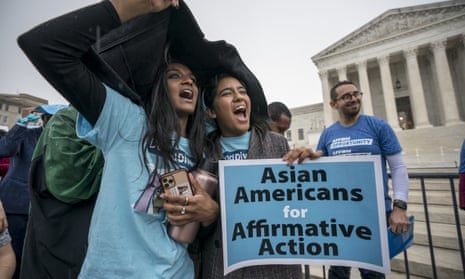What was affirmative action designed to do – and what did it achieve?

“The US supreme court could be poised to ban the use of affirmative action policies in college admissions as soon as Thursday. The court, which is expected to deliver its ruling either this week or next, will determine whether race-conscious admissions violate the equal-protection clause under the US constitution.
Envisioned as a tool to help remedy historical discrimination and create more diverse student bodies, affirmative action policies have permitted hundreds of colleges and universities to factor in students’ racial backgrounds during the admissions process. That consideration is supplementary, and taken in tandem with other factors such as applicants’ test scores, grades and extracurricular activities.
Even with race-conscious admissions, however, many selective public and private colleges and universities struggle to enroll diverse student populations that accurately reflect society. At the University of North Carolina, for example, in a state where 21% of people are Black, just 8% of the school’s undergraduates are Black.
Opponents of affirmative action, such as the advocacy group Students for Fair Admissions, argue that considering race as a factor in the admissions process amounts to racial discrimination – particularly against Asian Americans. SFA has brought cases against Harvard University, the nation’s oldest private university, and UNC, the nation’s first public university, to challenge their affirmative action policies, which the group contends favors Black and Latino students. Ultimately, it hopes that race considerations will be nixed from the admissions process entirely, and replaced by race-neutral or “color-blind” policies.
The concept of affirmative action originated in 1961 when President John F Kennedy issued an executive order directing government agencies to ensure that all Americans get an equal opportunity in employment. President Lyndon Johnson took it one step further in 1965, barring public and private organizations that had a federal contract from discriminating based on race, color, religion, and national origin. The prohibition was added to the Civil Rights Act of 1964.
In 1969, President Richard Nixon’s assistant labor secretary, Arthur Fletcher, who would eventually be known as the “father of affirmative action,” pushed for requiring employers to set “goals and timetables” to hire more Black workers. That effort, known as the Revised Philadelphia Plan, would later influence how many schools approached their own race-conscious admissions programs.
The practice was challenged when Allan Bakke, a white man who was twice denied entry to the medical school at the University of California at Davis, sued the university, arguing that its policies, which included allocating seats for “qualified” students of color, discriminated against him. In 1978, the supreme court narrowly rejected the use of “racial quotas”, but noted that colleges and universities could use race as a factor in the admissions process. Justice Lewis Powell noted that achieving diversity represented a “compelling government interest.”
What has affirmative action in college admissions actually achieved?
After generations of near total exclusion of Black students and other students of color, colleges and universities began admitting more diverse groups in the 1960s and 70s, and soon thereafter incorporated race-consciousness into their admissions policies.
Data shows that the rise of affirmative action policies in higher education has bolstered diversity on college campuses. In 1965, Black students accounted for roughly 5% of all undergraduates. And between 1965 and 2001, the percentage of Black undergraduates doubled. The number of Latino undergraduates also rose during that time. Still, the practice of factoring race into the admissions process faced repeated attacks: In 1998, during an era of conservatism, California voters approved Proposition 209, which outlawed affirmative action in any state or government agency, including its university system. Since then, eight more states have eliminated such race-conscious policies.
What could happen next?
The end of affirmative action at those state levels shows just how impactful the consideration of race in admissions has been: A UC Berkeley study found that after the ban in California, the number of applicants of color in the UC system “sharply shifted away from UC’s most selective Berkeley and UCLA campuses, causing a cascade of students to enroll at lower-quality public institutions and some private universities”. Specifically, the number of Black freshmen admittedto UC Berkeley dropped to 3.6% between 2006 and 2010 – almost half of its population before the ban.
In an amicus brief in the Harvard case, attorneys for the University of Michigan, which had to stop considering race in admissions in 2006, argued that despite “persistent, vigorous and varied efforts” to achieve diversity, it has struggled to do so without race-consciousness. The number of Black and Native American students has “dramatically” dropped since the end of affirmative action in the state.
Though students of color remain underrepresented at selective colleges and universities today, institutions argue that their presence helps shape students’ on-campus experiences. The possible removal of race consideration from college admissions would set a precedent for a less diverse school system, which stands in stark contrast to an increasingly diverse world.”
I
No comments:
Post a Comment